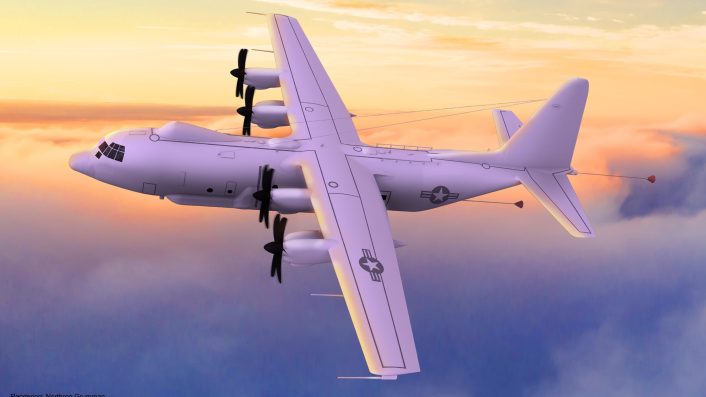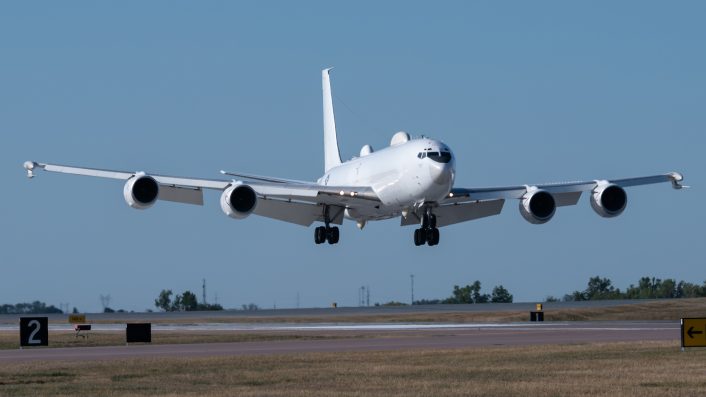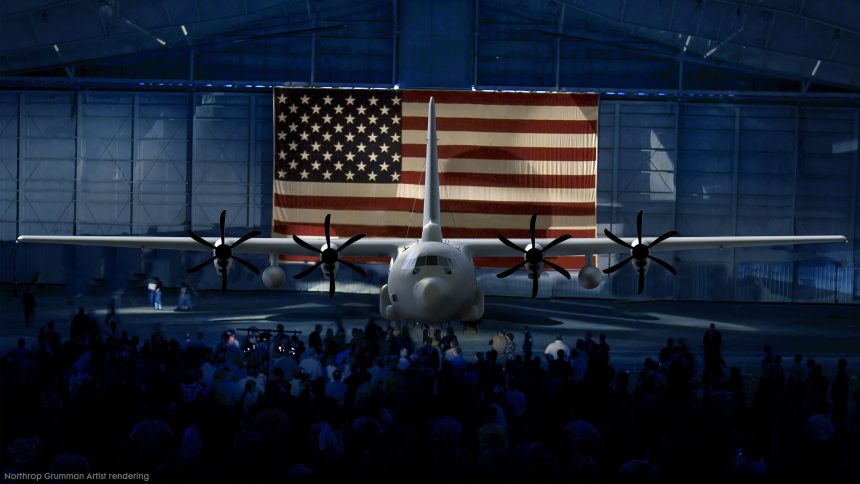The name is a nod to the C-130 platform already fulfilling the TACAMO mission as EC-130Q between 1963 and 1993.
After designating last year the selection of the E-130J designation for the new Take Charge and Move Out (TACAMO) mission aircraft, the U.S. Navy has now announced that Phoenix II will be it official popular name. The service says the name represents the mythical bird, whose ability is to be reborn, in a nod to the proven C-130 platform fulfilling the TACAMO mission as EC-130Q between 1963 and 1993.
E-130J Phoenix II
“Phoenix II is the ideal popular name as we take the E-130J TACAMO mission into its next phase,” said Capt. Roger Davis, PMA-271 program manager. “A phoenix is known for its resilience, exceptionally long lifespan, and its ability to transform and continue its purpose. The dedicated team at PMA-271 have committed to the ideals of TACAMO’s critical deterrence mission when executing this new platform; transforming the legacy mission aircraft into a new weapon system with unmatched survivability and longevity for this country.”
The announcement was made by PMA-271 together with Strategic Communications Wing 1 (SCW-1), which will employ the aircraft. SCW-1 oversees the “Ironmen” of Fleet Air Reconnaissance Squadron (VQ) 3, “Shadows” of VQ-4 and “Roughnecks” of VQ-7, home based out of Tinker Air Force Base, Oklahoma. VQ-7 is the Fleet Replacement Squadron (FRS) that provides aircrew to VQ-3 and VQ-4.
“I’m pleased that this very important program remains on track, and that we were able to leverage our community sailors and veterans through the process,” said Capt. Britt Windeler, commander of SCW-1. “I feel like Phoenix II is especially apt, as we are returning to our roots of executing the TACAMO mission on a C-130 variant.”

New TACAMO platform
PMA-271 is procuring the E-130J through the TACAMO Recapitalization Program, whose most likely candidate was already considered to be the Super Hercules. Northrop Grumman, Lockheed Martin’s Skunk Works and Raytheon Intelligence and Space teamed up to bid for the program in 2023.
The solicitation, which closed in April 2024, is for a prime contractor to integrate TACAMO mission systems, including the Collins Aerospace Very Low Frequency (VLF) subsystem, into government-furnished C-130J-30 aircraft. The contract award is scheduled for January 2025, said NAVAIR in the press release.
The E-130J would become the 18th variant of the C-130 Hercules, according to a Lockheed Martin 2020 brochure which mentions that the Hercules already has 17 mission variants. However, the use of the type for the TACAMO mission is not a novelty, as the E-6B replaced another Hercules variant, the EC-130Q which was based on the C-130H.
Lockheed Martin already released in 2022 a concept for what it called the EC-130J, which included the trailing wires of the VLF antenna, enlarged and extended landing gear fairings, multiple domes extending both from the top and the bottom fuselage and fairings for other equipment on the wingtips. Back then, the first new aircraft was expected to arrive at NAS Patuxent River, Maryland, in Fiscal Year 2026.

Among the expected modifications are also electromagnetic pulse (EMP) hardening and cybersecurity hardening. Compared to the E-6B, however, the E-130J is not expected to Air Force’s Airborne Command Post (ABNCP) capability, which allows to communicate with the nuclear bombers and ICBM (InterContinental Ballistic Missiles) silos, as it will be reportedly integrated on the new Survivable Airborne Operations Center (SAOC) aircraft.
The E-6B Mercury
The E-130J Phoenix II will recapitalize the aging E-6B Mercury fleet that has been in service for more than three decades. The E-6B Mercury, commonly known by many as the “Doomsday Plane“, plays an extremely important role for the U.S. National Security: they are used to relay instructions to the fleet ballistic missile submarines in case of nuclear war but also act as backups of the four E-4Bs NAOC (National Alternate Operations Center), working as ABNCP (Airborne Command Post) platforms.
Because of its sensitive mission, the Mercury is capable of communicating on virtually every radio frequency band, on commercial satellites and on the Internet, using also a secure VOIP system. The aircraft are often trackable online while performing various critical missions, flying orbits while trailing their antennas or exploiting a particular geostationary satellite for radio comms.
The transmissions from these antennas can be received using commercially available radio equipment but the messages themselves are transmitted in code, forming strings of letters and numbers called Emergency Action Messages (EAMs). These messages are similar to, and sometimes identical in terms of content, those transmitted on high frequency (HF) radio via the High Frequency Global Communications System (HFGCS).

Among the Mercury’s missions are the so-called Looking Glass mission (mirroring the ground-based C3 center at Offutt AFB and relaying orders); talking to submarines trailing a 26,000 ft wire antenna; launching commands to ICBMs (InterContinental Ballistic Missiles) via Airborne Launch Control System, and performing C3 (Command Control Communication) operations to forces operating in theater or to the U.S. strategic bombers flying Global Strike missions.
The U.S. Navy has a fleet of 16 E-6Bs operated by the Strategic Communications Wing 1 (SCW-1) squadrons home based out of Tinker Air Force Base, Oklahoma. They include the “Ironmen” of Fleet Air Reconnaissance Squadron (VQ) 3, “Shadows” of VQ-4 and “Roughnecks” of VQ-7.









